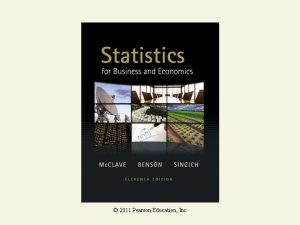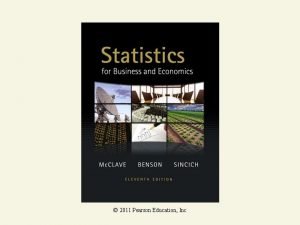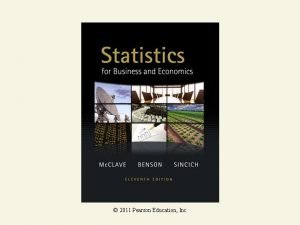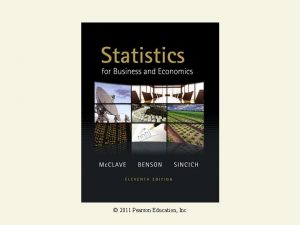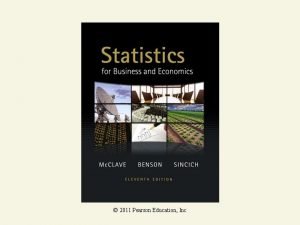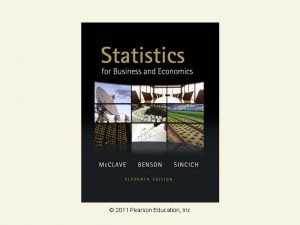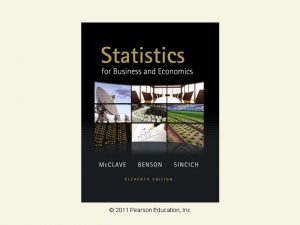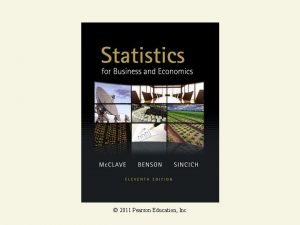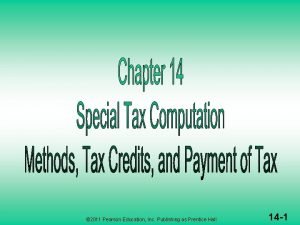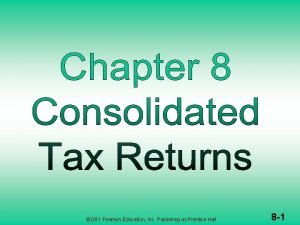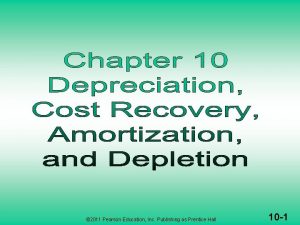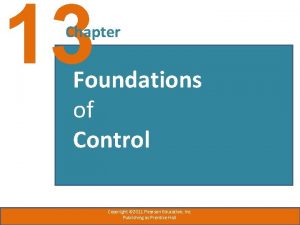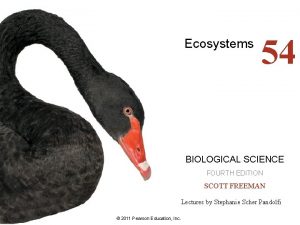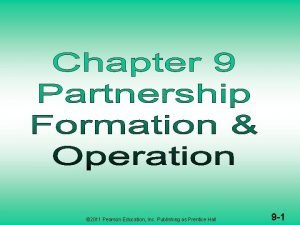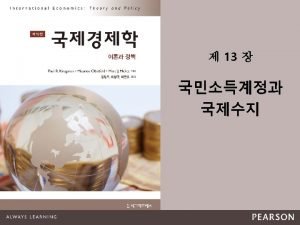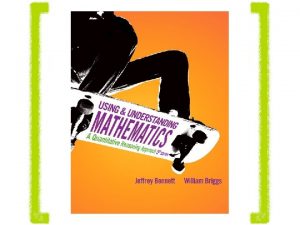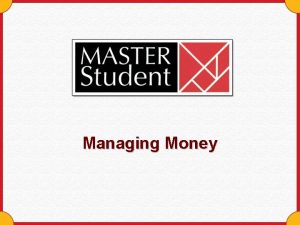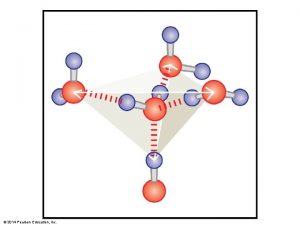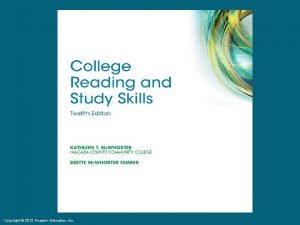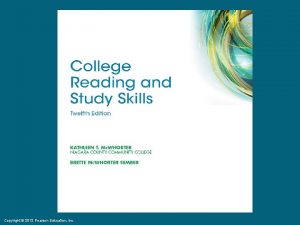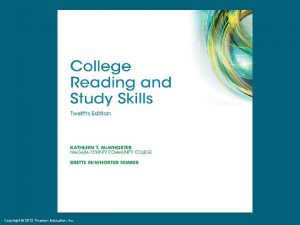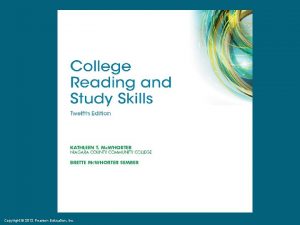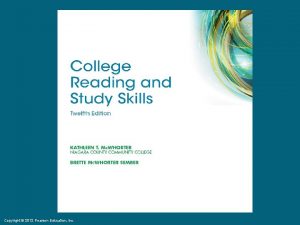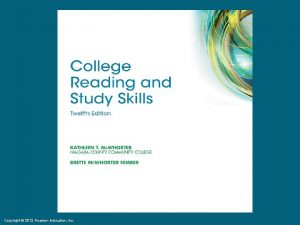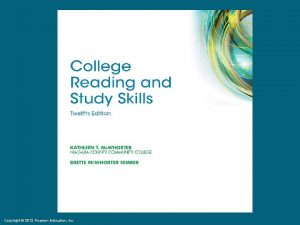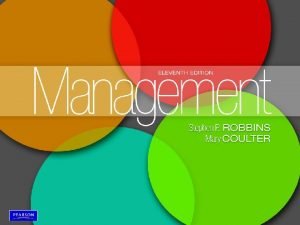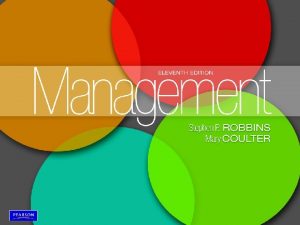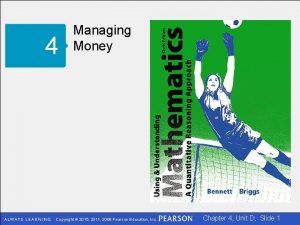Managing Your Money Copyright 2011 Pearson Education Inc














































- Slides: 46


Managing Your Money Copyright © 2011 Pearson Education, Inc.

Unit 4 A Taking Control of Your Finances Copyright © 2011 Pearson Education, Inc. Slide 4 -3

4 -A Controlling Your Finances n n Know your bank balance. Never bounce a check or have a debit card rejected. Know what you spend. Keep track of debit and credit card spending. Don’t buy on impulse. Think first; buy only if the purchase makes sense. Make a budget, and don’t overspend it. Copyright © 2011 Pearson Education, Inc. Slide 4 -4

4 -A A Four-Step Budget 1. List all monthly income, including a prorated amount for any income not received monthly (such as once-a-year payments). 2. List all monthly expenses, including a prorated amount for expenses that don’t recur monthly. 3. Subtract total expenses from total income to determine your net monthly cash flow. 4. Make adjustments as needed. Copyright © 2011 Pearson Education, Inc. Slide 4 -5

4 -A College Expenses Example: You pay $3500 for tuition, $750 in student fees, and $500 for textbooks each semester. How should you handle these expenses in computing your monthly budget? Amount paid over a whole year: Prorated Amount: Put $800 per month into your expense list. Copyright © 2011 Pearson Education, Inc. Slide 4 -6

4 -A Base Financial Goals on Solid Understanding n n Find a way to make your budget allow for savings; understand how savings work and how to choose appropriate savings plans. Understand the basic mathematics of loans. Understand how taxes are computed and how they can affect your financial decisions. Understand how the federal budget affects future personal finances. Copyright © 2011 Pearson Education, Inc. Slide 4 -7

4 -A Unit 4 B The Power of Compounding Copyright © 2011 Pearson Education, Inc. Slide 4 -8

4 -A Definitions n n n The principal in financial formulas is the balance upon which interest is paid. Simple interest is interest paid only on the original principal, and not on any interest added at later dates. Compound interest is interest paid on both the original principal and on all interest that has been added to the original principal. Copyright © 2011 Pearson Education, Inc. Slide 4 -9

4 -A Compound Interest Formula for Interest Paid Once a Year A = accumulated balance after Y years P = starting principal APR = annual percentage rate (as a decimal) Y = number of years Copyright © 2011 Pearson Education, Inc. Slide 4 -10

4 -A Simple and Compound Interest Compare the growth in a $100 investment for 5 years at 10% simple interest per year and at 10% interest compounded annually. The compound interest account earns $11. 05 more than the simple interest account. Copyright © 2011 Pearson Education, Inc. Slide 4 -11

4 -A Example #1 Your $160, 000 home has been discovered to appreciate at a rate of 1. 6% per year. What will its value be after 12 years? P = $160, 000 APR = 1. 6% or 0. 016 y = 12 A = 160, 000 x (1 + 0. 016)12 On your calculator 160, 000(1. 016)^12 A = $193, 572. 87 Copyright © 2011 Pearson Education, Inc. Slide 4 -12

4 -A Example #2 Your $60, 000 BMW has been discovered to depreciate at a rate of 0. 5% per year. What will its value be after 7 years? A = 60, 000 x (1 – 0. 005)7 P = $60, 000 APR = – 0. 5% or – 0. 005 y=7 On your calculator 60, 000(0. 995)^7 A = $57, 931. 24 Copyright © 2011 Pearson Education, Inc. Slide 4 -13

4 -A Definitions n Present value is the original principal. n Future value is the accumulated amount. Copyright © 2011 Pearson Education, Inc. Slide 4 -14

Compound Interest Formula for Interest Paid n Times per Year 4 -A A = accumulated balance after Y years P = starting principal APR = annual percentage rate (as a decimal) n = number of compounding periods per year Y = number of years Copyright © 2011 Pearson Education, Inc. Slide 4 -15

4 -A Compound Interest Show quarterly compounding affects a $1000 investment at 8% per year. Copyright © 2011 Pearson Education, Inc. Slide 4 -16

4 -A Example 3 You deposit $40, 000 in an account that pays an Annual Percentage Rate of 3. 6% compounded monthly. If you make NO further deposits or withdrawals, how much money will be in the account after 81/2 years? A = 40, 000(1 + 0. 036/12)12 x 8. 5 On your Calculator 40, 000(1. 003)^102 P = $40, 000 APR = 3. 6% or 0. 036 y = 8. 5 n = 12 Copyright © 2011 Pearson Education, Inc. A = $54, 292. 42 Slide 4 -17

4 -A Example 4 Your company buys a $14 million dollar machine. You are allowed to deduct the depreciation at an APR of 2. 6% compounded weekly. What will the machine be worth (to the nearest $100, 000) after 6 years? A = 1. 4 E 6(1 – 0. 026/52)52 x 6 On your Calculator 1. 4 E 6(0. 9995)^312 P = $1. 4 x 106 APR = 2. 6% or 0. 026 y=6 n = 52 Copyright © 2011 Pearson Education, Inc. A = $12, 000 Slide 4 -18

4 -A Definition n The annual percentage yield (APY) is the actual percentage by which a balance increases in one year. It is sometimes also called the effective yield or simply the yield. APY = relative increase = Copyright © 2011 Pearson Education, Inc. absolute increase starting principal Slide 4 -19

4 -A APR vs. APY APR = annual percentage rate APY = annual percentage yield APY = APR if interest is compounded annually APY > APR if interest is compounded more than once a year Copyright © 2011 Pearson Education, Inc. Slide 4 -20

4 -A Continuous Compounding Show different compounding periods affect the APY for an APR of 8%. Copyright © 2011 Pearson Education, Inc. Slide 4 -21

4 -A Continuous Compounding Copyright © 2011 Pearson Education, Inc. Slide 4 -22

4 -A Compound Interest Formula for Continuous Compounding A = accumulated balance after Y years P = starting principal APR = annual percentage rate (as a decimal) Y = number of years = a special irrational number with a value of Copyright © 2011 Pearson Education, Inc. Slide 4 -23

4 -A Example 5 You deposit $1000 in the Second State Bank of Wisconsin compounded continuously at an APR or 4%. How much would be in your account after 6 years? A = 1000 e. 04 x 6 P = $1000 APR = 4% or 0. 04 y=6 Copyright © 2011 Pearson Education, Inc. On your Calculator 1000 e^0. 24 A = $1, 271. 25 Slide 4 -24

4 -A Example 7 Assume that your ancestors on July 4, 1776 invested $100 in an account that compounded continuously at an APR of 3%. How much money will be in the account as of July 4, 2013? A = 100 e. 03 x 237 P = $100 APR = 3% or 0. 04 y = 237 Copyright © 2011 Pearson Education, Inc. On your Calculator 100 e^7. 11 A = $122, 414. 75 Slide 4 -25

4 -A Group Work Assignment n p. 224 -225 43 -61 odd, 81, 83 Copyright © 2011 Pearson Education, Inc. Slide 4 -26

4 -A Unit 4 C Savings Plans and Investments Copyright © 2011 Pearson Education, Inc. Slide 4 -27

4 -A Savings Plan Formula (Regular Payments) A = accumulated savings plan balance PMT = regular payment (deposit) amount APR = annual percentage rate (as a decimal) n = number of payment periods per year Y = number of years Copyright © 2011 Pearson Education, Inc. Slide 4 -28

4 -A Example 7 You establish a savings account that you deposit $50 per bi-monthly paycheck. The account pays 2. 4% APR. How much will there be in the account after 5 years? 10 years? PMT = $50 APR = 2. 4% or 0. 024 y=5 n = 24 Copyright © 2011 Pearson Education, Inc. On your Calculator 50((1. 001)^125– 1)/(0. 001) After 5 years A = $6, 653. 88 After 10 years A = $14, 193. 25 Slide 4 -29

4 -A Definitions n n n An annuity is any series of equal, regular payments. An ordinary annuity is a savings plan in which payments are made at the end of each month. An annuity due is a plan in which payments are made at the beginning of each period. The future value of an annuity is the accumulated amount at some future date. The present value of a savings plan is a lump sum deposit that would give the same end result as regular payments into the plan. Copyright © 2011 Pearson Education, Inc. Slide 4 -30

4 -A Total Return Consider an investment that grows from an original principal P to a later accumulated balance A. The total return is the relative change in the investment value: Copyright © 2011 Pearson Education, Inc. Slide 4 -31

4 -A Annual Return Consider an investment that grows from an original principal P to a later accumulated balance A in Y years. The annual return is the annual percentage yield (APY) that would give the same overall growth. Copyright © 2011 Pearson Education, Inc. Slide 4 -32

4 -A Total Return Example: Suppose that you decided to invest in some real estate property in the year 2004. The amount of your original investment is $27, 500. In the year 2013 you decide to sell and receive $43, 400 for the property. What is your total return percentage? Copyright © 2011 Pearson Education, Inc. Slide 4 -33

4 -A Annual Return Example: Suppose that you decided to invest in some real estate property in the year 2004. The amount of your original investment is $27, 500. In the year 2013 you decide to sell and receive $43, 400 for the property. What is your annual return percentage? Copyright © 2011 Pearson Education, Inc. Slide 4 -34

4 -A Types of Investments Stock (or equity) gives you a share of ownership in a company. n n n Invest some principal amount to purchase the stock. The only way to get your money out is to sell the stock. Stock prices change with time, so the sale may give you either a gain or a loss on your original investment. Copyright © 2011 Pearson Education, Inc. Slide 4 -35

4 -A Types of Investments A bond (or debt) represents a promise of future cash. n n n Buy a bond by paying some principal amount to the issuing government or corporation. The issuer pays you simple interest (as opposed to compound interest). The issuer promises to pay back your principal at some later date. Copyright © 2011 Pearson Education, Inc. Slide 4 -36

4 -A Types of Investments Cash investments generally earn interest and include the following: n n n Money you deposit into bank accounts Certificates of deposit (CD) U. S. Treasury bills Copyright © 2011 Pearson Education, Inc. Slide 4 -37

4 -A Investment Considerations n n n Liquidity: How difficult is it to take out your money? Risk: Is your investment principal at risk? Return: How much return (total or annual) can you expect on your investment? Copyright © 2011 Pearson Education, Inc. Slide 4 -38

4 -A Stock Market Trends Copyright © 2011 Pearson Education, Inc. Slide 4 -39

4 -A Financial Data—Stocks In general, there are two ways to make money on stocks: 1. Sell a stock for more than you paid for it, in which case you have a capital gain on the sale of the stock. 2. Make money while you own the stock if the corporation distributes part or all of its profits to stockholders as dividends. Copyright © 2011 Pearson Education, Inc. Slide 4 -40

4 -A The Financial Pages Copyright © 2011 Pearson Education, Inc. Slide 4 -41

4 -A NYSE Composite Transactions Copyright © 2011 Pearson Education, Inc. Slide 4 -42

4 -A Financial Data—Bonds are issued with three main characteristics: 1. The face value (or par value) is the price you must pay the issuer to buy the bond. 2. The coupon rate of the bond is the simple interest rate that the issuer promises to pay. 3. The maturity date is the date on which the issuer promises to repay the face value of the bond. Copyright © 2011 Pearson Education, Inc. Slide 4 -43

4 -A Financial Data—Mutual Funds When comparing mutual funds, the most important factors are the following: 1. The fees charged for investing (not shown on most mutual fund tables) 2. Measures of how well the manager is doing with the fund’s money Note: Past performance is no guarantee of future results. Copyright © 2011 Pearson Education, Inc. Slide 4 -44

4 -A Mutual Fund Quotations Copyright © 2011 Pearson Education, Inc. Slide 4 -45

4 -A Group Work Assignment n P. 244 -245 9 -14, 23 -29 odd, 37, 39, 44, 47 Copyright © 2011 Pearson Education, Inc. Slide 4 -46
 2011 pearson education inc
2011 pearson education inc 2011 pearson education inc
2011 pearson education inc 2011 pearson education inc
2011 pearson education inc 2011 pearson education inc
2011 pearson education inc 2011 pearson education inc
2011 pearson education inc 2011 pearson education inc
2011 pearson education inc 2011 pearson education inc
2011 pearson education inc 2011 pearson education inc
2011 pearson education inc Pearson education inc publishing as pearson prentice hall
Pearson education inc publishing as pearson prentice hall 2011 pearson education inc
2011 pearson education inc Pearson education inc. publishing as prentice hall
Pearson education inc. publishing as prentice hall Pearson education inc publishing as pearson prentice hall
Pearson education inc publishing as pearson prentice hall 2011 pearson education
2011 pearson education 2011 pearson education inc biology
2011 pearson education inc biology 2011 pearson education inc
2011 pearson education inc 2011 pearson education inc biology
2011 pearson education inc biology 2011 pearson education inc
2011 pearson education inc 2011 pearson education inc
2011 pearson education inc 2011 pearson education inc
2011 pearson education inc Pearson education ltd
Pearson education ltd Copyright by pearson education inc. answers
Copyright by pearson education inc. answers 2010 pearson education inc
2010 pearson education inc 2009 pearson education inc
2009 pearson education inc 2018 pearson education inc
2018 pearson education inc 2014 pearson education inc
2014 pearson education inc Copyright 2010 pearson education inc
Copyright 2010 pearson education inc Copyright 2010 pearson education inc
Copyright 2010 pearson education inc Copyright by pearson education inc. answers
Copyright by pearson education inc. answers Copyright 2003 pearson education inc
Copyright 2003 pearson education inc Copyright 2009 pearson education inc
Copyright 2009 pearson education inc Copyright pearson education inc
Copyright pearson education inc Copyright 2010 pearson education inc
Copyright 2010 pearson education inc Copyright 2010 pearson education inc
Copyright 2010 pearson education inc Copyright 2010 pearson education inc
Copyright 2010 pearson education inc Copyright 2010 pearson education inc
Copyright 2010 pearson education inc Copyright 2010 pearson education inc
Copyright 2010 pearson education inc Composition copyright example
Composition copyright example Copyright 2010 pearson education inc
Copyright 2010 pearson education inc Copyright 2009 pearson education inc
Copyright 2009 pearson education inc Copyright 2009 pearson education inc
Copyright 2009 pearson education inc Copyright 2009 pearson education inc
Copyright 2009 pearson education inc 2009 pearson education inc
2009 pearson education inc Copyright pearson education inc
Copyright pearson education inc Pearson education inc publishing as pearson prentice hall
Pearson education inc publishing as pearson prentice hall Pearson education inc. 2012
Pearson education inc. 2012 2008 pearson prentice hall inc
2008 pearson prentice hall inc Copyright 2005 pearson prentice hall inc
Copyright 2005 pearson prentice hall inc
